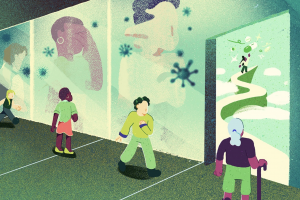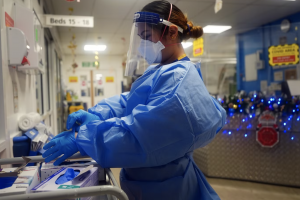Experts Remain Divided on Long COVID Treatments
Summary from the AllSides News Team
More than two years into the COVID-19 pandemic, researchers remain divided on long COVID and how to cure its symptoms.
The CDC currently defines post-COVID conditions as a wide range of ongoing health problems that can last weeks, months or years after an initial COVID-19 infection. One recent study from King’s College London identified three different "subtypes" of long COVID that affect different body systems: neurological symptoms (brain fog or headaches), respiratory symptoms (chest pain or shortness of breath) and immune-related symptoms (heart palpitations or muscle pains). About one in eight (12.7%) of people diagnosed with COVID-19 reported longstanding symptoms at least three months after their initial diagnosis, according to a report from The Lancet. Nature.com (Center bias) suggested in a recent feature that researchers are conducting at least 26 randomized trials to test therapies for long-COVID. The report accentuated one immunologist who compared long COVID research to the Wild West and noted that most of the trials being conducted are too small in scale to provide precise results. Axios (Center bias) noted that the ambiguity around long COVID has prompted doctors to "repurpose older drugs developed for other conditions."
Reports across the spectrum were divided on how significant a threat long COVID poses. While some reports labeled long COVID estimates as "startlingly high" and "pretty scary," others downplayed the data as "smaller" than initial suggestions and claimed that the Omicron variant might lead to long COVID "only half as often" as Delta did.
Featured Coverage of this Story
From the Center
Long-COVID treatments: why the world is still waiting
Bhasha Mewar has had it with doctors. Over the past two years, Mewar has spent nearly all of her life savings seeing heart and respiratory specialists, haematologists, urologists, dermatologists and more, in a desperate bid to tame her long-COVID symptoms. She has taken a slew of drugs: beta blockers to calm her racing heart, steroid inhalers to ease her laboured breathing and an antimalarial drug prescribed to her for reasons she never fully understood.
And when Mewar — a curator at an art museum in Ahmedabad, India, who has been...
From the Left
Long Covid now has three types - and each has its own set of symptoms
There are three different types of long Covid and each has its own set of symptoms, according to researchers.
Experts from King’s College London examined 1,459 people living with long Covid - defined by the study authors as suffering symptoms for at least 84 days after infection - and found there appeared to be three “subtypes” of the condition.
A pre-print of the study, published on medRxiv, revealed people with long Covid appeared to be split into three main groups, including:
- Those with neurological symptoms including fatigue, brain fog ...
From the Right
Omicron Risk for Long COVID Is Lower Than Earlier Variants: Doctor
When Carrie Anna McGinn woke up alone in her hotel room on Christmas morning in 2020, she thought she was experiencing the worst of her COVID symptoms. She struggled against coughing, cognitive dysfunction, pain, and postural orthostatic tachycardia syndrome.
She was isolated away from her family but expected to be back to normal in time for the New Year’s Eve celebrations. But when January came, many of her symptoms never went away, she told Macleans Magazine.
This past January, McGinn recognized a heartbreaking anniversary—it had been over a year since she...
AllSides Picks

April 19th, 2024

April 19th, 2024

April 19th, 2024

More News about Coronavirus from the Left, Center and Right
From the Left
From the Center
From the Right




